Annual report 2004 - Compagnia di San Paolo
Annual report 2004 - Compagnia di San Paolo
Annual report 2004 - Compagnia di San Paolo
You also want an ePaper? Increase the reach of your titles
YUMPU automatically turns print PDFs into web optimized ePapers that Google loves.
Institutional activities in <strong>2004</strong><br />
Health<br />
PET-CT Centre: Cyclotron and Ra<strong>di</strong>ochemistry and Ra<strong>di</strong>o Pharmacy Laboratory<br />
<strong>San</strong> Giovanni Battista Hospital, Turin<br />
PET-CT (Positron Emission Tomography - Computed<br />
Tomography) is a non–invasive <strong>di</strong>agnostic imaging<br />
system based on the use of ra<strong>di</strong>oactive tracers which,<br />
incorporated within complex molecules, are<br />
administered to the patient. The significance and the<br />
amount of the <strong>di</strong>stribution of the tracers inside the human<br />
body get detailed metabolic-functional information on<br />
biochemical processes which regulate the “state of<br />
health” or the onset of illness.<br />
PET is a valid <strong>di</strong>agnosis tool in oncology, car<strong>di</strong>ology and<br />
neurology. In particular, in oncology PET represents a<br />
valid option both for documenting metastases in a single<br />
examination and to <strong>di</strong>stinguish between recurrent<br />
tumour and ra<strong>di</strong>ation necrosis.<br />
The benefits of PET firstly relate to the quality of<br />
assistance to the patient, with less painful, risky,<br />
traumatising or invasive <strong>di</strong>agnostic procedures, and<br />
reducing patients exposure to ionising ra<strong>di</strong>ation of<br />
artificial origin. Another benefit of PET is cost<br />
containment, thanks to the reduction of <strong>di</strong>agnostic<br />
procedures, a more precise staging of the illness and the<br />
improvement of the <strong>di</strong>agnoses reliability.<br />
One estimate on the epidemiological data and the<br />
evidence of PET impact has shown the need for Piedmont<br />
in 7,000 tests per year in the start up stage and 15,000<br />
tests per year working at full capacity.<br />
In the light of those considerations, the <strong>Compagnia</strong><br />
granted an award of € 2.5 million in 2002 for the<br />
purchase of PET equipment, and € 6 million in <strong>2004</strong> for<br />
the production of a Cyclotron-Ra<strong>di</strong>o Pharmacy structure<br />
suitable for the <strong>di</strong>stribution of the ra<strong>di</strong>otracer FDG.<br />
The PET Centre of the <strong>San</strong> Giovanni Battista Hospital in<br />
Turin (Molinette) will be made up of: a PET scanner<br />
<strong>di</strong>splaying the spatial <strong>di</strong>stribution of the ra<strong>di</strong>otracers<br />
subject to <strong>di</strong>agnostic examination; a cyclotron (the only<br />
one in the Province of Turin), for the production of ra<strong>di</strong>o<br />
nuclides for PET <strong>di</strong>agnosis, in clinical activities and<br />
applied research, and the provision of FDG to other Turin<br />
health facilities; a ra<strong>di</strong>o chemistry-ra<strong>di</strong>o pharmacy<br />
laboratory to produce the ra<strong>di</strong>otracers.<br />
The ra<strong>di</strong>ochemistry - ra<strong>di</strong>o pharmacy laboratory will be<br />
equipped for the production and the quality control of the<br />
ra<strong>di</strong>otracers produced for PET <strong>di</strong>agnosis, respecting the<br />
regulation in force on the subject.<br />
The presence of a <strong>di</strong>agnostic service at <strong>San</strong> Giovanni<br />
Battista Hospital of Turin which does not depend on third<br />
party production services for ra<strong>di</strong>otracers will allow the<br />
Hospital to <strong>di</strong>stribute the ra<strong>di</strong>otracer FDG to various<br />
users in the Turin area. It will also allow to perform PET<br />
tests with ra<strong>di</strong>otracers other than FDG, planning high<br />
profile research activities, also thanks to the university<br />
context and the existing network of scientific relations.<br />
57



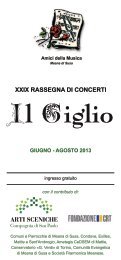
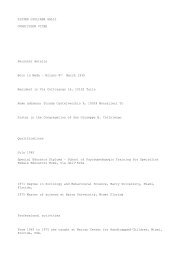
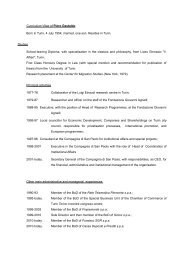
![ArchivioStorico 178 [PDF] - Compagnia di San Paolo](https://img.yumpu.com/47667361/1/185x260/archiviostorico-178-pdf-compagnia-di-san-paolo.jpg?quality=85)

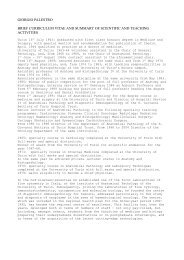
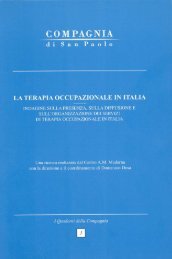
![brochure spazio 768 [PDF] - Compagnia di San Paolo](https://img.yumpu.com/36141511/1/190x255/brochure-spazio-768-pdf-compagnia-di-san-paolo.jpg?quality=85)

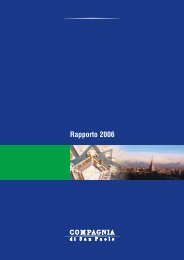
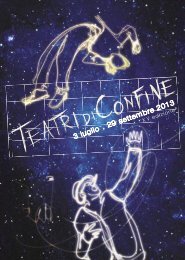

![Rapporto annuale 2008 [PDF] - Compagnia di San Paolo](https://img.yumpu.com/30320485/1/184x260/rapporto-annuale-2008-pdf-compagnia-di-san-paolo.jpg?quality=85)